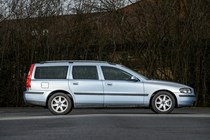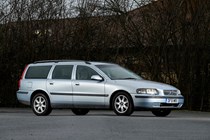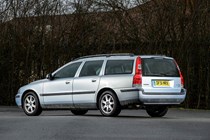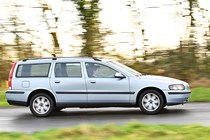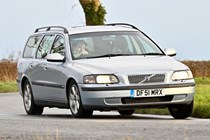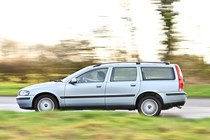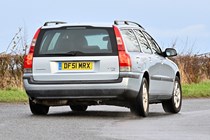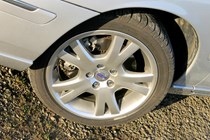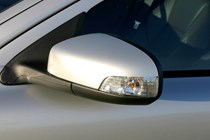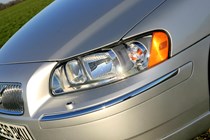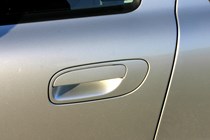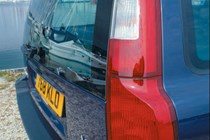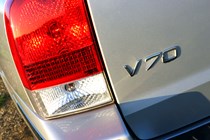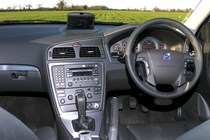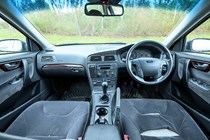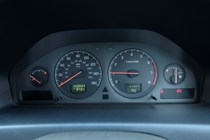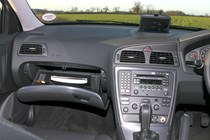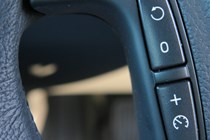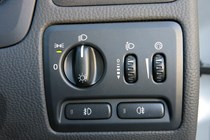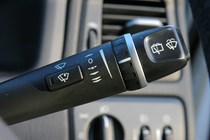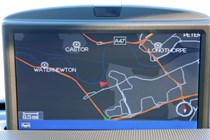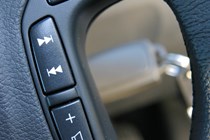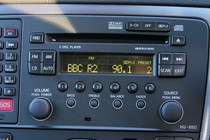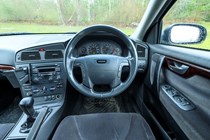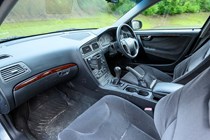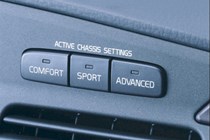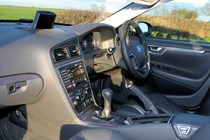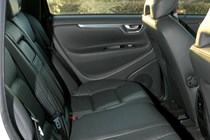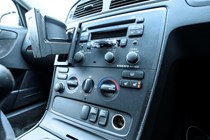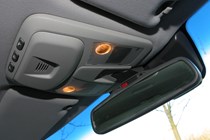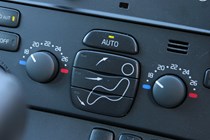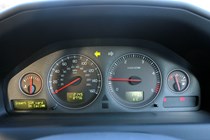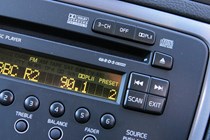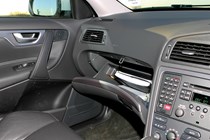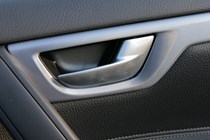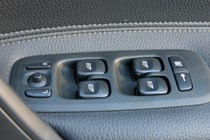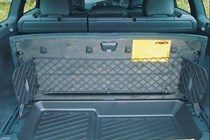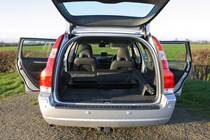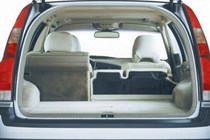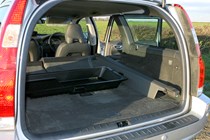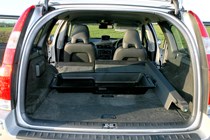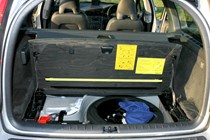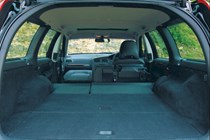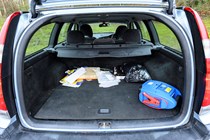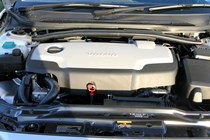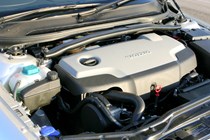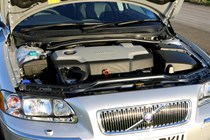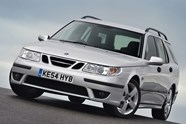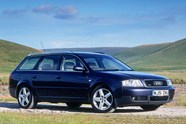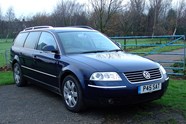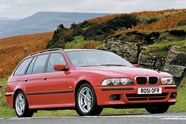
Volvo V70 (2000–2007) used car buying guide: Spruce moose for canny buyers
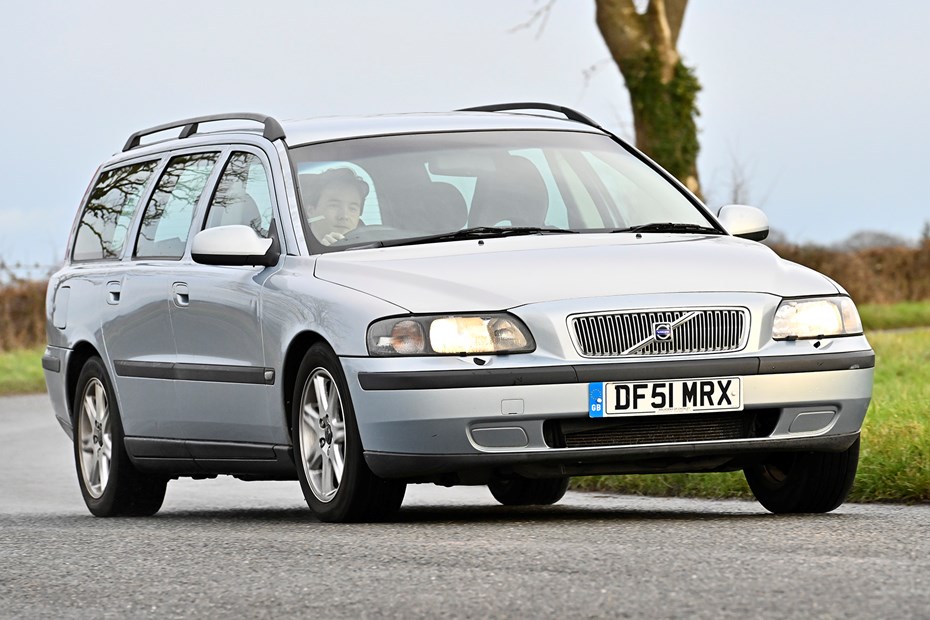
At a glance
| Price new | £20,345 - £39,732 |
|---|---|
| Used prices | £598 - £4,764 |
| Road tax cost | £315 - £760 |
| Insurance group | 27 - 43 |
Get an insurance quote with

|
|
| Fuel economy | Not tested to latest standards |
| Range | 172 - 662 miles |
| Number of doors | 5 |
| View full specs for a specific version | |
Available fuel types
Petrol
Diesel
Alternative fuel
Pros & cons
- Exceptionally comfortable and refined on long journeys
- Strong five-cylinder engines with proven reliability
- Huge boot and excellent practicality for families or load-luggers
- Suspension and auto gearbox issues are common on high-mileage examples
- Running costs can be high, especially on performance models
- Some electrical faults and ageing interior trim can be frustrating
Volvo V70 (00-07) rivals
Overview
For many family buyers with a taste for comfort, space and Swedish sturdiness, the Volvo V70 Mk2 was the go-to estate car during the early 2000s. This second-generation model – sold from 2000 to 2007 – built on Volvo’s reputation for safety and practicality. Today, there are still many in daily use, suggesting excellent longevity and reliability, despite the fast versions emerging as desirable modern classics.
The V70 was developed alongside the S60 saloon and uses the same platform, meaning it feels far more car-like to drive than the older 850-based version. Whether you’re looking at a frugal D5 diesel, a solid five-cylinder petrol, or the muscular T5 and R performance models, the V70 is versatile, understated and often surprisingly well-equipped.
Should you consider alternatives like the contemporary Saab 9-5 wagon, Audi A6 Avant or BMW 5 Series Touring? Perhaps the Mercedes-Benz E-Class estate? They’re all excellent choices – but few match the V70’s blend of comfort, reliability and rock bottom prices in the used market.
Volvo V70 buying guide
The V70’s appeal lies in its solidity and long-legged cruising ability, but it’s not without flaws. These are heavy, complex cars, often with intergalactic mileages and long histories. While mechanical durability is generally good – especially on well-maintained D5 diesels – many common issues relate to suspension, electronics and age-related wear.
Prices start from less than £1,000 for high-mileage or cosmetically tired examples, rising to £5,000+ for cherished facelift models with low mileage, full service history and desirable specs. With so many on the market, choosing carefully is crucial.
Volvo V70 Mk2 known faults and common problems
Common issues, and what to look for if you’re thinking of buying a Volvo V70 (2000–2007)
1. SUSPENSION ISSUES
V70s are heavy cars, and their suspension takes the brunt of poor roads and big loads. Front wishbones, drop links and top mounts wear quickly, often resulting in clonks or vague steering. Rear suspension can sag if the self-levelling Nivomat system (on some models) fails – replacements are expensive.
2. D5 DIESEL ISSUES
The early D5 engine (2001–2005) is strong but suffers from vacuum leaks, EGR valve clogging and turbo control problems. Expect smoky starts, hesitation or a lit-up dashboard if maintenance has lapsed. Later D5s from 2005 onwards (Euro 4) are smoother and more refined but more complex.
3. AUTO GEARBOX WOES
Most V70s are automatic, but the Geartronic five-speed can develop issues if the fluid isn’t changed regularly (despite Volvo’s ‘sealed for life’ claim). Look for clunky changes, flare between gears or slipping under load. Manual models have heavy clutches and dual-mass flywheels that wear out eventually.
4. ABS AND ELECTRICAL ISSUES
ABS modules can fail, throwing up warning lights – particularly on early cars. Electrical faults are common across the range, especially failed sensors, airbag warnings and central locking gremlins. Poor battery voltage or dirty fusebox connections can cause mysterious faults.
5. DOOR MODULE FAILURES
It’s not unusual for window switches, mirror motors or door locks to misbehave. Often the culprit is a failing door module, which can be costly if you’re chasing problems across multiple doors. This can also afflict the tailgate, which will either stick in the locked – or unlocked – state. Bear also that the alarm module battery can fail, rendering the system troublesome and in some cases inoperative – an annoying, rather than expensive fix.
6. DIM PROBLEMS
The Dashboard Information Module (DIM) – essentially the instrument cluster – is known to fail, leading to flickering displays or total loss of gauges. Refurbishment is possible, but expect costs in the hundreds if you’re replacing it.
7. OIL LEAKS AND BREATHER BLOCKS
Many five-cylinder petrols and diesels suffer from oil leaks, often from cam seals or sump gaskets. A blocked PCV breather system can pressurise the crankcase and make it worse. Rev the engine and remove the dipstick – smoke or vacuum? Bad news. In other news if it leaks when filling up with fuel, it needs a new filler neck – an awful job, that involves dropping the rear subframe.
8. POOR HEATER PERFORMANCE
Cabin heating issues are common and typically trace back to a failed heater matrix or blocked heater core. A whiff of coolant in the cabin is a tell-tale sign. It’s not a huge job, but it’s fiddly – and essential for winter comfort.
9. INTERIOR ISSUES
While Volvo interiors are hard-wearing, age and use do take a toll. Expect sagging headlinings, broken cupholders, tired leather and sticky dash buttons. Not dealbreakers, but a tidy cabin suggests a cared-for car.
10. R MODELS NEED TLC
Fast, rare and still desirable, the V70 R is tempting – but be warned. They feature complex AWD systems, pricey Brembo brakes, and active 4C suspension that can be ruinous if neglected. Avoid ones with lowered suspension or ECU remaps unless you’re sure it’s been done properly.
What models and trims can you buy?
There’s a wide spread of engines and trims in the Volvo V70 (2000–2007) range, which means there’s something to suit most tastes – whether you’re after a dependable family load-lugger or a fast sleeper estate.
The engine line-up starts with the 2.4-litre five-cylinder petrol in both non-turbocharged and turbocharged forms. The standard 2.4i is smooth and reliable, though not especially quick or economical. Step up to the 2.4T or T5, and things get a lot more interesting – these turbocharged versions offer strong mid-range punch, with the T5 in particular delivering a genuinely rapid turn of pace that still surprises today. Thirst, however, is part of the deal.
The 2.0T is a bit of an oddity in the UK – it’s a lower-boost turbocharged engine that’s more common on the continent. Rare, but worth considering if you want petrol smoothness with a slightly gentler tax bill and real-world running costs.
Diesel buyers are most likely to encounter the D5, and it’s arguably the best all-rounder. Early 163hp versions (badged D5) are simpler and more robust, while later 185hp cars (from 2005 onwards) are smoother and quicker, but feature a more complex emissions system. Both offer excellent long-distance economy, often returning more than 45mpg on the motorway, and they’re very long-lived with proper servicing.
If performance is your thing, the V70 R deserves a look. Using a 2.5-litre turbo engine with up to 300hp and Haldex all-wheel drive, it’s the flagship of the range and quick enough to surprise hot hatches. That said, maintenance costs are high, and the 4C active suspension can be a money pit if it fails – which it often does. Look for standard-spec cars on original suspension, and steer clear of hard-modified examples unless you’re feeling brave.
There are also a handful of Bi-Fuel models that run on LPG as well as petrol. These can be cheap to run – particularly if you do high mileages – but the LPG system can be troublesome if it hasn’t been serviced regularly. LPG availability is also patchy in the UK, so it’s worth checking your local area before committing.
Trim levels vary across the years, but generally include S, SE, Sport and Executive models. Entry-level cars are well-equipped for the age, with climate control, cruise control and electric windows all standard. SE models add nicer trim materials and alloy wheels, while Sport versions come with firmer suspension and unique styling touches. Executive cars are fully loaded, with leather upholstery, wood trim and premium audio.
Facelift cars from 2005 onwards are worth seeking out. As well as tidier styling and better refinement, they often come with upgraded infotainment, Bluetooth and better fuel economy on D5 versions.
Over the next few pages, we’ll review each aspect of the Volvo V70, taking into account its practicality, comfort, fuel economy and performance. If you’re short on time, you can also skip to our verdict page to see if we recommend it as a good used car.
Video: We bought a Volvo V70

See how our £1,000 eBay Volvo V70 performed against two other affordable modern classics.



